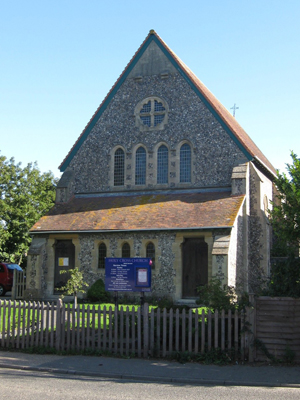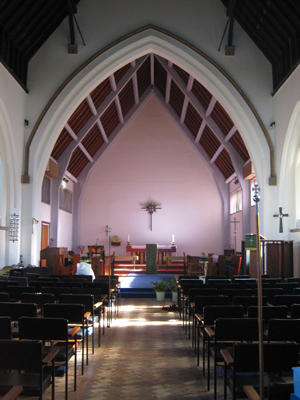| |
 |
 |
 |
| Comment on this report, or find other reports. |
 |
| Our Mystery Worshippers are volunteers who warm church pews for us around the world. If you'd like to become a Mystery Worshipper, start here. |
 |
| Find out how to reproduce this report in your church magazine or website. |
|
|
| 2071: Holy
Cross, North Bersted, Bognor Regis, West Sussex, England |
 |
 |
 |
Mystery Worshipper:
Teutonic Knight.
The church:
Holy
Cross, North Bersted, Bognor Regis, West Sussex, England.
Denomination:
Church of England, Diocese
of Chichester.
The building:
Holy Cross had its beginnings in 1880 when a thatched cottage,
formerly a blacksmith's, was licensed for divine services. In
1894 a mission hall replaced this cottage; the hall survives
as the present day nave. A chancel was added in 1930 and enlarged
in 1973. The building has triple lancets along the sides and
four on the west wall above a low narthex. The interior is plain
save for the long side windows under the eaves divided by mullions
into narrow pastel-coloured lights. On the windowless east wall
hangs a rather interesting modern cross. The fittings date from
1971, save the font, which is said to come from a pre-1894 mission
hall.
The church:
They seem to be quite active with social events. A harvest festival
is scheduled for early October, along with blessing of animals.
July saw a mini-market and garden party. The church hall is
made available to rent for parties and meetings. Two eucharists
are celebrated Sunday mornings, with an informal family service
held in the afternoon. Morning prayer and eucharist take place
during the week.
The neighbourhood:
Bognor Regis is a seaside resort town on England's south coast.
Originally known as Bognor, it was renamed by King George V
when he underwent a rest cure there in 1929. Although the fresh
sea air was beneficial to His Majesty's health, he is said to
have uttered some rather unkind words about the place as he
lay dying. Bognor Regis has a long beach which, in line with
the coastal defence scheme, is now sadly completely covered
with shingle except at low tide. There is also a pier and the
usual attractions of a seaside resort. The church's main claim
to fame is probably its proximity to Bognor's legendary landmark
"the pink pub at the double mini-roundabout", a/k/a
the Royal Oak.
The cast:
The Revd Ann Clarke, priest-in-charge.
The date & time:
Holy Cross Sunday, 12 September 2010, 10.30am.
What was the name of the service?
Sung Eucharist.
How full was the building?
about two-thirds full (60 people at a guess). Funnily, the north
half of the building was a lot fuller than the south. There
were a couple of (crying) babes in arms, a toddler, two or three
children, and all of seven men!
Did anyone welcome you personally?
The welcoming party had stationed themselves in such a way that
you had to turn around to face them as you entered through the
narthex. I've had better welcomes. However, this was outweighed
by the fact that the priest-in-charge immediately spotted the
"one or two faces I do not know" during her pre-service
welcome talk, and an exchange of very friendly handshakes and
personal words during the peace.
Was your pew comfortable?
Padded chairs with armrests and hassocks underneath: squashy,
comfortable, and amazingly not squeaky (they usually are!).
How would you describe the pre-service
atmosphere?
There was loud, vibrant and happy chatter. The organ played
a few quiet pieces that seemed to have neither beginning nor
end and sounded a bit like the organist could not decide what
to play. Scores of candles were set out along the window sills
and a Taizé cross was placed in front of the altar in honour
of the day, which was feast of title for this church.
What were the exact opening words of the
service?
"Good morning and welcome on this 12th of September"
followed by an ad hoc prayer to collect our thoughts. Mrs Clarke
was not attired in full regalia for this. The cast then assembled
at the west end and processed in.
What books did the congregation use during the
service?
Hymns Old and New (Anglican Edition), a service sheet
for the eucharist, and a sheet with the readings for the day
and the usual notices.
What musical instruments were played?
Organ and a (very) small choir, and a guitar right at the end
for a birthday song.
Did anything distract you?
A bus or lorry rumbling past, an ambulance with blaring siren passing by (more on this later). The blinding bright sunlight streaming in through the coloured south windows hitting my pew and hymn book. People in front of me actually turned sideways to avoid this glare. It possibly explained the uneven occupation pattern of seats.

Was the worship stiff-upper-lip, happy clappy, or
what?
Relaxed and friendly, almost chummy. There was a sitting room
atmosphere during the sermon, which was told like a story by
the fireside. I found it highly amusing to hear this style of
worship described as "very Catholic" a few days later during
an ecumenical gathering in the area.
Exactly how long was the sermon?
13 minutes.
On a scale of 1-10, how good was the preacher?
7 – The priest-in-charge spoke without notes, reiterating
the readings in an explanatory way that never got boring, though
sometimes a bit rambling. She was clearly enjoying herself as
she delved into childhood memories of snake-hunting.
In a nutshell, what was
the sermon about?
The readings had been especially selected for the feast of title:
Numbers 21:4-9 (God commands Moses to lift up a bronze snake
on a pole); Philippians 2:6-11 (Christ humbled himself to die
on a cross, and so God exalted him); and John 3:13-17 (just
as Moses lifted up the snake, so must Christ be lifted up).
Something that has the power to kill (snakes and the cross)
also has the power to heal; indeed , these are necessary for
healing. The ancient Roman symbol of the caduceus (snakes wound
round a rod) has been adopted by the medical profession and
is found on ambulances (said just as the ambulance passed by
outside with siren blaring). The symbol of the crucifix is not
the same as the symbol of the cross. The crucifix (with the
body of Christ affixed thereto) reminds us of Christ's suffering
and death for our salvation; the cross (without Christ's body)
reminds us of his glorious resurrection, of healing. Never be
ashamed of confessing your faith, be it by wearing outward symbols
or not.
Which part of the service
was like being in heaven?
The moment during the sermon when I recognised that the modern
piece of artwork on the eastern wall (which I initially found
merely irritating and quite ugly) was meant to symbolise a crown
of thorns super-imposed on the cross. It grew on me.
And which part was like being in... er... the other place?
The incessant chatter during the anthem and post communion hymn
by someone at the back of the church.
What happened when you hung around after the service looking lost?
No time to look lost, as I was immediately invited for coffee by three different people before I had even risen from my seat. Sadly I could not stay.
How would you describe the after-service
coffee?
As mentioned, I couldn't stay to experience it.
How would you feel about making this church your regular (where 10 = ecstatic, 0 = terminal)?
7 – My first experience of a woman presiding at the eucharist
in my diocese. That alone is well worth a second visit, but
their choir is much too small.
Did the service make you feel glad to be a
Christian?
Not particularly as it reminded me that suffering is "necessary" and to be embraced.
What one thing will you remember about all this in seven days' time?
The ambulance going by during the "serpent on the pole"
talk. |
|
|
 |
 |
 |
| We rely on voluntary donations to stay online. If you're a regular visitor to Ship of Fools, please consider supporting us. |
 |
 |
 |
| The Mystery Pilgrim |
 |
| One of our most seasoned reporters makes the Camino pilgrimage to Santiago de Compostela in Spain. Read here. |
 |
 |
 |
| London churches |
 |
| Read reports from 70 London churches, visited by a small army of Mystery Worshippers on one single Sunday. Read here. |
| |
|
|
|
|


